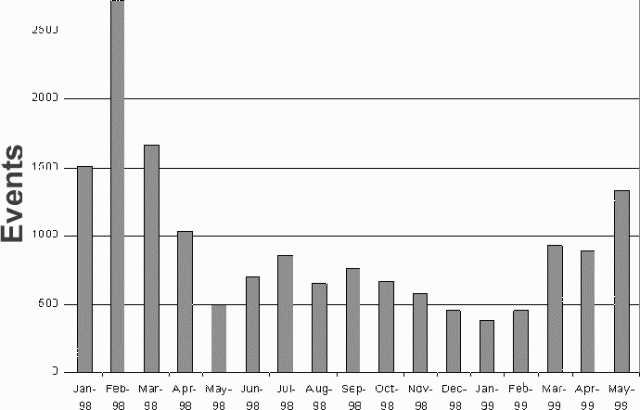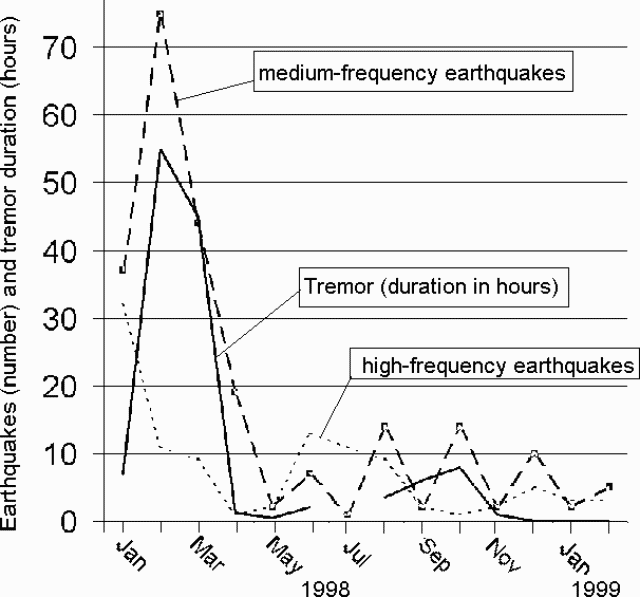Report on Poas (Costa Rica) — June 1999
Bulletin of the Global Volcanism Network, vol. 24, no. 6 (June 1999)
Managing Editor: Richard Wunderman.
Poas (Costa Rica) Strong drop in tremor duration and mid-frequency earthquakes in early 1998
Please cite this report as:
Global Volcanism Program, 1999. Report on Poas (Costa Rica) (Wunderman, R., ed.). Bulletin of the Global Volcanism Network, 24:6. Smithsonian Institution. https://doi.org/10.5479/si.GVP.BGVN199906-345040
Poas
Costa Rica
10.2°N, 84.233°W; summit elev. 2697 m
All times are local (unless otherwise noted)
Seismicity registered at station POA2, located 2.8 km SW of the active crater, has declined since early 1998 (figures 71 and 72). Since then, gas columns continued to reach altitudes between 500 and 600 m above the floor of the crater as they had during the interval of greater seismicity. The pyroclastic cone remained the focus of fumarolic activity. The crater's W, E, and SE walls continued to slip into the lake. The lake maintained a constant bubbling on its S and SE edges. The active lake's color varied considerably; for example, at various times during April 1999, the ~32°C lake water appeared green, turquoise, or light blue. In November 1998, the lake appeared greenish turquoise and had a temperature of 29°C.
 |
Figure 71. Low-frequency earthquakes at Poás each month during January 1998-May 1999. Courtesy of OVSICORI-UNA. |
Geological Summary. The broad vegetated edifice of Poás, one of the most active volcanoes of Costa Rica, contains three craters along a N-S line. The frequently visited multi-hued summit crater lakes of the basaltic-to-dacitic volcano are easily accessible by vehicle from the nearby capital city of San José. A N-S-trending fissure cutting the complex stratovolcano extends to the lower N flank, where it has produced the Congo stratovolcano and several lake-filled maars. The southernmost of the two summit crater lakes, Botos, last erupted about 7,500 years ago. The more prominent geothermally heated northern lake, Laguna Caliente, is one of the world's most acidic natural lakes, with a pH of near zero. It has been the site of frequent phreatic and phreatomagmatic eruptions since an eruption was reported in 1828. Eruptions often include geyser-like ejections of crater-lake water.
Information Contacts: E. Fernandez, V. Barboza, E. Duarte, R. Saenz, E. Malavassi, M. Martinez, and R. Van der Laat, T. Marino, and E. Hernandez, Observatorio Vulcanologico y Sismologico de Costa Rica, Universidad Nacional (OVSICORI-UNA), Apartado 86-3000, Heredia, Costa Rica; Wendy Perez Fernandez, Seccion de Seismologia, Vulcanologia y Exploracion Geofisica, Escuela Centroamericana de Geologia, Universidad de Costa Rica, POB 35-2060, San Jose, Costa Rica.


